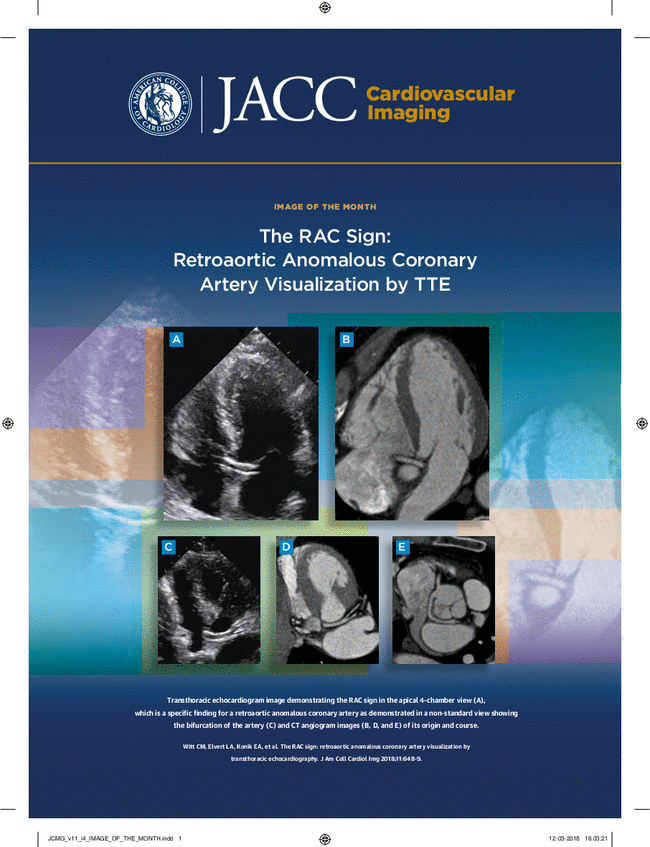A Deep Learning Model to Identify Mitral Valve Prolapse From the Echocardiogram.
IF 15.2
1区 医学
Q1 CARDIAC & CARDIOVASCULAR SYSTEMS
引用次数: 0
Abstract
BACKGROUND Mitral valve prolapse (MVP) has a prevalence of 2% to 3% and increases risk of heart failure and sudden death, but diagnosis by transthoracic echocardiography requires time and expertise. OBJECTIVES This study aims to develop a deep learning model DROID-MVP (Dimensional Reconstruction of Imaging Data-Mitral Valve Prolapse) to classify MVP from digital echocardiogram videos. METHODS DROID-MVP was trained and validated using 1,043,893 echocardiogram videos (48,829 studies) from 16,902 cardiology patients at MGH (Massachusetts General Hospital), and externally validated in 8,888 MGH primary care patients and 257 primary care patients at BWH (Brigham and Women's Hospital). The authors tested associations among DROID-MVP predictions (range: 0-1), mitral regurgitation (MR) severity, and mitral valve repair or replacement (MVR). RESULTS Of 16,902 patients (6,391 [38%] women; age 61 ± 16 years) in the derivation sample, 783 (4.6%) had MVP. DROID-MVP accurately identified MVP across the MGH cardiology internal validation set (area under the receiver-operating characteristic curve [AUROC]: 0.947 [95% CI: 0.910-0.984]; average precision [AP]: 0.682 [95% CI: 0.565-0.784]; prevalence: 0.036), MGH primary care external validation set (AUROC: 0.964 [95% CI: 0.951-0.977]; AP: 0.651 [95% CI: 0.578-0.716]; prevalence: 0.022), and BWH primary care external validation set (AUROC: 0.968 [95% CI: 0.946-0.989]; AP: 0.774 [95% CI: 0.666-0.797]; prevalence: 0.113). A high (>0.67) vs low (<0.33) DROID-MVP score was associated with moderate or severe MR (adjusted OR: 2.0 [95% CI: 1.1-3.8]; P = 0.030) and future MVR (adjusted HR: 3.7 [95% CI: 1.5-8.9]; P = 0.004). CONCLUSIONS A deep learning model identifies MVP from echocardiogram videos, and model predictions are associated with clinical endpoints including MR and future MVR. Deep learning can automate MVP diagnosis and potentially generate digital markers of clinically significant MVP.从超声心动图识别二尖瓣脱垂的深度学习模型。
背景:二尖瓣脱垂(MVP)的患病率为2%至3%,并增加心力衰竭和猝死的风险,但经胸超声心动图诊断需要时间和专业知识。目的建立深度学习模型DROID-MVP (Dimensional Reconstruction of Imaging data -二尖瓣脱垂),对数字超声心动图视频中的二尖瓣脱垂进行分类。方法sdroid - mvp通过来自麻省总医院(MGH) 16902名心脏病患者的1,043,893个超声心动图视频(48,829项研究)进行培训和验证,并在8888名MGH初级保健患者和257名BWH (Brigham and Women Hospital)初级保健患者中进行外部验证。作者测试了DROID-MVP预测(范围:0-1)、二尖瓣反流(MR)严重程度和二尖瓣修复或置换(MVR)之间的关系。结果在衍生样本的16902例患者中(6391例(38%)女性,年龄61±16岁),783例(4.6%)有MVP。DROID-MVP准确识别了MGH心内科内部验证集(患者工作特征曲线下面积[AUROC]: 0.947 [95% CI: 0.910-0.984],平均精度[AP]: 0.682 [95% CI: 0.565-0.784],患病率:0.036),MGH初级保健外部验证集(AUROC: 0.964 [95% CI: 0.951-0.977], AP: 0.651 [95% CI: 0.578-0.716],患病率:0.022),BWH初级保健外部验证集(AUROC: 0.968 [95% CI: 0.946-0.989], AP: 0.774 [95% CI: 0.666-0.797];流行:0.113)。高(>0.67)vs低(<0.33)DROID-MVP评分与中度或重度MR(校正or: 2.0 [95% CI: 1.1-3.8]; P = 0.030)和未来MVR(校正HR: 3.7 [95% CI: 1.5-8.9]; P = 0.004)相关。结论深度学习模型从超声心动图视频中识别MVP,模型预测与临床终点相关,包括MR和未来MVR。深度学习可以自动诊断MVP,并可能生成具有临床意义的MVP的数字标记。
本文章由计算机程序翻译,如有差异,请以英文原文为准。
求助全文
约1分钟内获得全文
求助全文
来源期刊

JACC. Cardiovascular imaging
CARDIAC & CARDIOVASCULAR SYSTEMS-RADIOLOGY, NUCLEAR MEDICINE & MEDICAL IMAGING
CiteScore
24.90
自引率
5.70%
发文量
330
审稿时长
4-8 weeks
期刊介绍:
JACC: Cardiovascular Imaging, part of the prestigious Journal of the American College of Cardiology (JACC) family, offers readers a comprehensive perspective on all aspects of cardiovascular imaging. This specialist journal covers original clinical research on both non-invasive and invasive imaging techniques, including echocardiography, CT, CMR, nuclear, optical imaging, and cine-angiography.
JACC. Cardiovascular imaging highlights advances in basic science and molecular imaging that are expected to significantly impact clinical practice in the next decade. This influence encompasses improvements in diagnostic performance, enhanced understanding of the pathogenetic basis of diseases, and advancements in therapy.
In addition to cutting-edge research,the content of JACC: Cardiovascular Imaging emphasizes practical aspects for the practicing cardiologist, including advocacy and practice management.The journal also features state-of-the-art reviews, ensuring a well-rounded and insightful resource for professionals in the field of cardiovascular imaging.
 求助内容:
求助内容: 应助结果提醒方式:
应助结果提醒方式:


